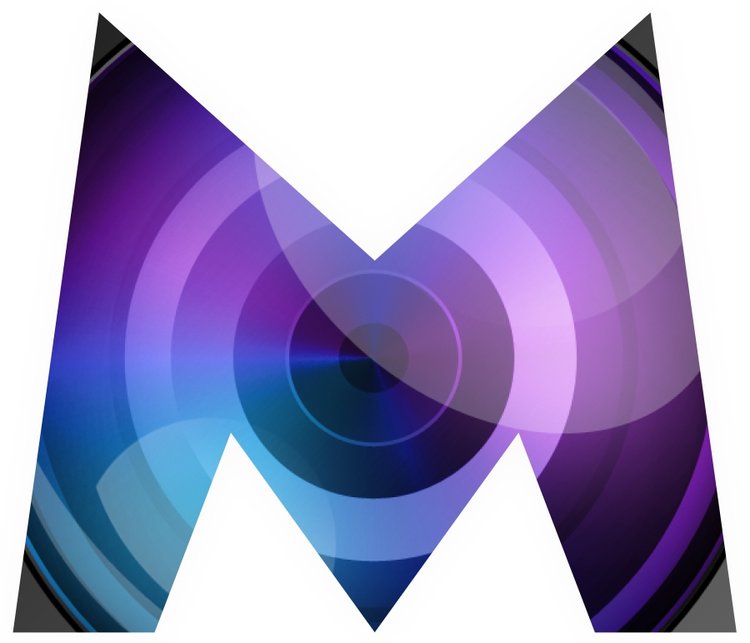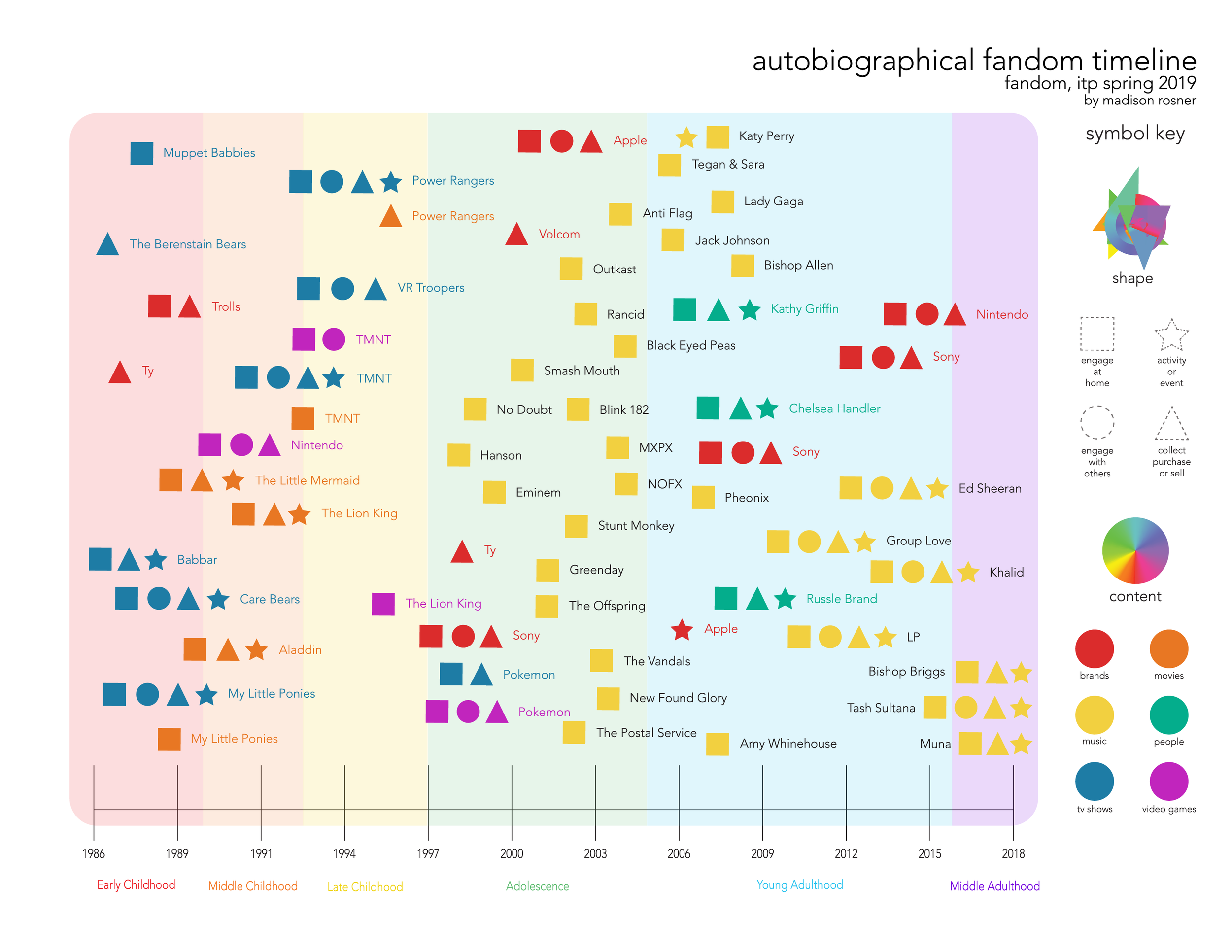The Miriam Webster defines fandom as the state or attitude of being a fan — this doesn’t seem to cut it considering fandom is so much more. It has been around primarily for nearly 30 years and can be further defined as an act of doing activities to become closer to a thing and feel belonging. It can be a subculture composed of fans characterized by a feeling of empathy and camaraderie with others who share a common interest.
For class this week, the assignment was to document our own fandom throughout our life and display it in a creative way, with our own aesthetic appeal. After putting this together — by asking my mom mainly on what I was interested in when I was younger — I noticed a trend of content intake trends that shifted during major shifts in my lifetime. During my childhood, I relied mostly on TV shows, Movies, and video games as my source of entertainment. Since human nature is to want to belong, I interacted with my friends by engaging in pretend and playing out the roles of the different characters from many of the content I consumed. Video games were also a big part of my childhood, as was the themed birthday parties and dressing as my favorite characters for halloween.
As I hit my adolescence years, I really got into music — mostly listening to the radio and downloading from Napster. I would make my own CD’s and listen often until MP3 players became a thing in the early 2000s. As I transitioned into early adulthood and started working and having funds, I was able to attend concerts and buy music (Napster changed it’s product at some point and iTunes was the place to go). I also listened to Pandora quite a bit and used a tool called Pandora Jam to record all of my Pandora fun to my computer. The one thing that stands out the most is that Music has been the most dynamic throughout my adult life, and TV Shows and Movies really took a back seat.
To build out the timeline, I used Adobe Illustrator to create the iconography and chart. I wanted to build something that I could potentially use for future projects as well as making something concise and organized to display the major points of fandom of my lifetime thus far. Although overwhelming to go back in time, it was really interesting to see the patterns unfold.
In addition to this assignment, we were asked to read and respond to the following articles:
Loving Music: Listeners, Entertainments, and the Origins of Music Fandom in Nineteenth-Century America by Daniel Cavicchi
In Loving Music, I found it interesting to read about how the act of following music and seeing artists was documented for the first time in American history — this movement was able to shape musical experiences entirely around commercial entertainments such as concerts, theater, and public exhibitions. This was all made possible by the advent of an increased wage economy, an act of rebellion, and more accessible transportation systems, which in turn brought music to more people outside of the upper class systems and was the beginning of fandom in America.
The idea of having fun or doing something for just the act of enjoying it was not a typical Victorian era concept or practice. The higher classes tended to watch music in private or learned to play themselves in the privacy of their own homes. Occasionally they would go to the opera, but that was merely to be seen out in public at a specific event of measure — not to be in the opera house listening to or watching the opera. Most activities of the upper classes were done for show and to check a box off their lists that created this illusive layer of completing what was meant to be the notch of showing their class levels and belonging. Although ridiculous, this was and still remains true in our social structures today. The mere act of doing to be noticed is incredibly frustrating and what seems to be pointless to me in the greater sense of what’s important in this world.
What I think was most interesting in this reading was the documentation of the quality of sound, quality of building, and other details that these fans of going to concerts began to develop. The amount of energy involved in this ‘hobby’ took women away from focussing on finding suitors and more time on themselves and what they wanted to do — this was unheard of for this era, and absolutely a rebellion agains their class structure and systems for what was considered appropriate for that timeframe. This act of rebelling was also shown in how these fans expressed their feelings about music publicly and were obviously not of the higher classes that typically would go to these types of events. They were breaking the rules of societal norms and were laying the foundation for the future of fandom to evolve and expand to more classes and social environments.
As music became a lower-class activity — primarily due to the increased accessibility in ease to travel and added means to fund these leisurely activities, more people were able to follow particular musicians and see their performances live. Jenny Lind was a singer that was repped/contracted by P.T. Barnum of Barnum and Baily’s. He orchestrated a tour that brought her across the United States to tour and created a following in the process. I watched the movie, The Greatest Showman last year and it follows the loose history of P.T. Barnum and Jenny Lind and the successes and downfalls of his career. In the movie, it was hyped as the greatest sensation to hit the lives of the American People — they travelled via train (newly built) and played at shows all across the United States. This was the beginning of this type of spectacle and laid the pavement for future businesses around creating opportunities for people to consume music via listening technologies and other ways to consume music such as better built concert halls.
There was a moment in the reading where these cult-like fans (aka music lovers) decided to take the big plunge and take pilgrimages to get glimpses of their favorite stars not performing — but merely doing normal things (sounds like the start of paparazzi) and even going as far as to breaking into the residences of some famous musicians. Alice Drake made the voyage out to Germany — I’m guessing by ship which probably took over a week (or close to two) to find the house of the deceased Franz LIszt, talking the house’s keeper into letting her into the house, and then getting to play on her favorite musicians piano. I can see the lure of this.. kind of. However, it seems absolutely insane to me to put this much effort into this type of journey back when resources were scarce and that type of travel was very lengthy. I’m amazed that this happened, but can see how this kind of excitement has turned dangerous over the years and would not be acceptable in our society today.
The author comments on how the audience of the concerts in the late nineteenth-century were able to creatively indulge their participation in their musical life due to a lasting personal connection and depth of feeling surrounding their experiences with music and others who shared their tastes. It’s interesting to me how this really isn’t too much different than today’s society and subcultures of fandom that are significantly affected and have the feeling of involvement within popular culture today. This way of seeking out connection beyond the show is still very (if not more) palpable today. Modern fandom in my opinion is nothing more than an evolved form of late nineteenth century fandom, where the additions of technological innovations have carved out new and different lanes to express fandom globally.
In The Gangs of Disney, Charles Lam digs in deep to the subculture of the Gangs of Disneyland and the rules and regulations that they live by. Just like in any gang, there are hierarchies and turfs that are mandated and maintained. What’s interesting is these ‘gangs’ have developed over time over the shared motivations to belong and have someone (or a group) to go to Disneyland with. There is a community base within the gang; I suppose safety as well, but there’s really so much security at Disneyland, that safety has really never been on my mind in all the years in which I’ve been an Annual Pass Member.
Now, don’t get me wrong — there are the super fans. I’ve seen them.. I’ve visited the park with them. I’ve even gone on special days of the week to celebrate special events with others — those days are so fun!! But I’ve been going to Disneyland all my life and have never noticed these gangs — maybe it’s something you have to look for, but I can’t recall seeing anyone fitting the descriptions as described in the article stand out. But then again, I grew up in Los Angeles and live on a street with rivalry gang members, so maybe it’s just my normal.
Regardless of my personal experience, I think it’s really interesting that these groups have developed and disbanded over the years (especially with the ease of acquiring a membership) and the addition of California Adventure (which allows alcohol consumption; Disneyland does not). In the sense of the formation of groups and self-policing within said group, it’s really interesting that this was all formed and curated over the shared love and the sense of belonging for Disney and Disneyland as a whole. Some groups are outstanding citizens and keep the park-goers in-line and hold them accountable for being good Disneyland citizens; others treat the territories as their own and get a bit violent. The rivalries that exist are concerning and the fact that there are fights (or rumors of fights) are a bit concerning.
If Fandom is defined as an act of doing activities to become closer to a thing and feel belonging, then there’s the place of class structure or superiority that is falling into this subculture of Disneyland Gangs. The idea that Fandom is a utopian environment is a myth and the hierarchy that is built-in is nothing more than a mirror of what can be found outside the park. All members are susceptible to conditions outside of Disney rules and can and most likely will default to social structures found outside. What is so interesting to me is the context in which these groups are choosing to interact — they are doing whatever they want and Disney is allowing it (for the most part).
With Disney not taking action (or public action) it almost feels as if this behavior is being excused in their method to not bring attention to it. It’s troubling really, and makes me think that there may be more reasons to the increased security that Disneyland has been integrating over the past few years. I thought it was a bit interesting last year when Disneyland moved their security screenings from a simple bag check at the entrance to the park (from parking lot) to before you enter the tram from the parking lot with TSA style screenings. Makes much more sense after reading this article and I’ll make sure to look out for a White Rabbit next time I go to the park!
x.

